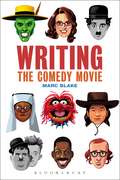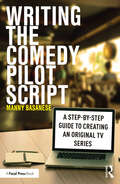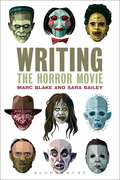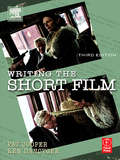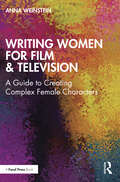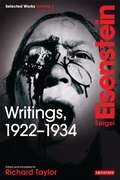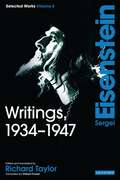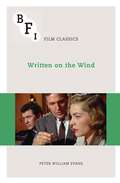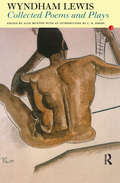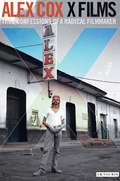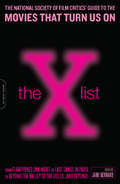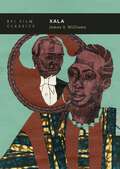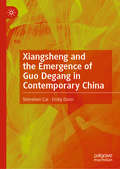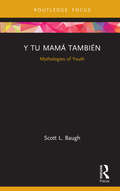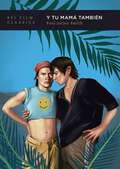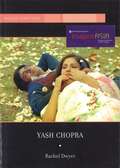- Table View
- List View
Writing the Comedy Movie
by Marc BlakeIt is often suggested that there are 'secrets' to comedy or that it is 'lightning in a bottle', but the craft of comedy writing can be taught. While comedic tastes change, over time and from person to person, the core underpinning still depends on the comedic geniuses that have paved the way. Great comedy is built upon a strong foundation. In Writing the Comedy Movie, Marc Blake lays out – in an entertainingly readable style – the nuts and bolts of comedy screenwriting. His objective is to clarify the 'rules' of comedy: to contextualize comedy staples such as the double act, slapstick, gross-out, rom com, screwball, satire and parody and to introduce new ones such as the bromance or stoner comedy. He explains the underlying principles of comedy and comedy writing for the screen, along with providing analysis of leading examples of each subgenre.
Writing the Comedy Pilot Script: A Step-by-Step Guide to Creating an Original TV Series
by Manny BasaneseNavigating through the challenging process of writing a comedy pilot, this book will help screenwriters to create an original script for television. Practical and accessible, the book presents a step-by-step guide focusing on the key elements of the process. Incorporating both the history of TV comedy as well as its current evolving state in this age of the dramedy and an ever-increasing variety of broadcast and streaming platforms, the book will serve as a guide for the fledgling sitcom scribe. Author Manny Basanese breaks down the comedy pilot writing process from what may be perceived as an overwhelming, time-consuming mission into a series of much more manageable, smaller steps (from logline to outline to 1st, 2nd and polished draft). Utilizing his experience in Hollywood’s sitcom trenches, the author offers real-world advice on such topics as building the comedy pilot "world," creating memorable comic characters, sound sitcom structure, and the importance of crafting an emotional through line in a comedy pilot. Finally, there is also practical career guidance for marketing this just-completed script and breaking into the industry with advice on various topics such as the value of networking as well as gaining representation in the competitive Hollywood jungle. It is ideal for students of screenwriting and aspiring comedy screenwriters.
Writing the Comedy Pilot Script: A Step-by-Step Guide to Creating an Original TV Series
by Manny BasaneseNavigating through the challenging process of writing a comedy pilot, this book will help screenwriters to create an original script for television. Practical and accessible, the book presents a step-by-step guide focusing on the key elements of the process. Incorporating both the history of TV comedy as well as its current evolving state in this age of the dramedy and an ever-increasing variety of broadcast and streaming platforms, the book will serve as a guide for the fledgling sitcom scribe. Author Manny Basanese breaks down the comedy pilot writing process from what may be perceived as an overwhelming, time-consuming mission into a series of much more manageable, smaller steps (from logline to outline to 1st, 2nd and polished draft). Utilizing his experience in Hollywood’s sitcom trenches, the author offers real-world advice on such topics as building the comedy pilot "world," creating memorable comic characters, sound sitcom structure, and the importance of crafting an emotional through line in a comedy pilot. Finally, there is also practical career guidance for marketing this just-completed script and breaking into the industry with advice on various topics such as the value of networking as well as gaining representation in the competitive Hollywood jungle. It is ideal for students of screenwriting and aspiring comedy screenwriters.
Writing the Horror Movie
by Marc Blake Sara BaileyTales of horror have always been with us, from Biblical times to the Gothic novel to successful modern day authors and screenwriters. Though the genre is often maligned, it is huge in popularity and its resilience is undeniable. Marc Blake and Sara Bailey offer a detailed analysis of the horror genre, including its subgenres, tropes and the specific requirements of the horror screenplay.Tracing the development of the horror film from its beginnings in German Expressionism, the authors engage in a readable style that will appeal to anyone with a genuine interest in the form and the mechanics of the genre. This book examines the success of Universal Studio's franchises of the '30s to the Serial Killer, the Slasher film, Asian Horror, the Supernatural, Horror Vérité and current developments in the field, including 3D and remakes. It also includes step-by-step writing exercises, annotated extracts from horror screenplays and interviews with seasoned writers/directors/ producers discussing budget restrictions, screenplay form and formulas and how screenplays work during shooting.
Writing the Horror Movie
by Marc Blake Sara BaileyTales of horror have always been with us, from Biblical times to the Gothic novel to successful modern day authors and screenwriters. Though the genre is often maligned, it is huge in popularity and its resilience is undeniable. Marc Blake and Sara Bailey offer a detailed analysis of the horror genre, including its subgenres, tropes and the specific requirements of the horror screenplay.Tracing the development of the horror film from its beginnings in German Expressionism, the authors engage in a readable style that will appeal to anyone with a genuine interest in the form and the mechanics of the genre. This book examines the success of Universal Studio's franchises of the '30s to the Serial Killer, the Slasher film, Asian Horror, the Supernatural, Horror Vérité and current developments in the field, including 3D and remakes. It also includes step-by-step writing exercises, annotated extracts from horror screenplays and interviews with seasoned writers/directors/ producers discussing budget restrictions, screenplay form and formulas and how screenplays work during shooting.
Writing the Short Film
by Patricia Cooper Ken DancygerThe short film is a unique narrative art form that, while lending itself to experimentation, requires tremendous discipline in following traditional filmic considerations. This book takes the student and novice screenwriter through the storytelling process- from conception, to visualization, to dramatization, to characterization and dialogue- and teaches them how to create a dramatic narrative that is at once short (approximately half an hour in length) and complete. Exercises, new examples of short screenplays, and an examination of various genres round out the discussion.NEW TO THE THIRD EDITION: new screenplays, a chapter on rewriting your script, and a chapter on the future of short films
Writing the Short Film
by Patricia Cooper Ken DancygerThe short film is a unique narrative art form that, while lending itself to experimentation, requires tremendous discipline in following traditional filmic considerations. This book takes the student and novice screenwriter through the storytelling process- from conception, to visualization, to dramatization, to characterization and dialogue- and teaches them how to create a dramatic narrative that is at once short (approximately half an hour in length) and complete. Exercises, new examples of short screenplays, and an examination of various genres round out the discussion.NEW TO THE THIRD EDITION: new screenplays, a chapter on rewriting your script, and a chapter on the future of short films
Writing Women for Film & Television: A Guide to Creating Complex Female Characters
by Anna WeinsteinThis book is a detailed guide to creating complex female characters for film and television. Written for screen storytellers of any level, this book will help screenwriters and filmmakers recognize complicated portrayals of women on screen and evaluate the complexity of their own characters. Author Anna Weinstein provides a thorough analysis of key female characters in film and television, illustrating how some of our greatest screenwriters have developed smart, nuanced, and intriguing characters that successfully portray the female experience. The book features in-depth discussions of women’s representation both on screen and behind the scenes, including interviews with acclaimed women screenwriters and directors from around the globe. These conversations detail their perspectives on the relevance of women’s screen stories, the writing and development processes of these stories, and the challenges in getting female characters to the screen. With practical suggestions, exercises, guidelines, and a review of tired clichés to avoid, this book leaves readers prepared to draw their own female characters with confidence. A vital resource for screenwriters, filmmakers, and directors, whether aspiring or already established, who seek to champion the development of rich, layered, and unforgettable female characters for film and television.
Writing Women for Film & Television: A Guide to Creating Complex Female Characters
by Anna WeinsteinThis book is a detailed guide to creating complex female characters for film and television. Written for screen storytellers of any level, this book will help screenwriters and filmmakers recognize complicated portrayals of women on screen and evaluate the complexity of their own characters. Author Anna Weinstein provides a thorough analysis of key female characters in film and television, illustrating how some of our greatest screenwriters have developed smart, nuanced, and intriguing characters that successfully portray the female experience. The book features in-depth discussions of women’s representation both on screen and behind the scenes, including interviews with acclaimed women screenwriters and directors from around the globe. These conversations detail their perspectives on the relevance of women’s screen stories, the writing and development processes of these stories, and the challenges in getting female characters to the screen. With practical suggestions, exercises, guidelines, and a review of tired clichés to avoid, this book leaves readers prepared to draw their own female characters with confidence. A vital resource for screenwriters, filmmakers, and directors, whether aspiring or already established, who seek to champion the development of rich, layered, and unforgettable female characters for film and television.
Writings, 1922-1934: Sergei Eisenstein Selected Works, Volume 1
by Sergei EisensteinI.B. Tauris is delighted to announce the reissue in paperback in three volumes of the definitive, most comprehensive edition, in the finest translations and fully annotated, of the writings of this great filmmaker, theorist and teacher of film - and one of the most original aesthetic thinkers of the twentieth century. Now in paperback for the first time, Volume 1 documents from the definitive Russian texts the complex course of Sergei Eisenstein's writings during the revolutionary years in the Soviet Union. It presents Eisenstein the innovative aesthetic thinker, socialist artist and humourist, passionately engaged in the debates over the art forms of the future. Importantly, this was also the period of Eisenstein's great silent masterpieces, 'The Strike', 'The Battleship Potemkin', 'October' and 'The General Line', and of his controversial sojourns in Hollywood and Mexico.
Writings, 1934-1947: Sergei Eisenstein Selected Works, Volume 3
by Sergei EisensteinSergei Mikhailovich Eisenstein (1898-1948) was not only one of the world's greatest film-makers; he was also one of the greatest theorists and teachers of film and one of the most original aesthetic thinkers of the twentieth century. Before the initial publication of Selected Works however, only fragmentary selections from his writings had been available in English and little had been published that made use of the wealth of material that had become available in Russian in the late Soviet period and beyond. Selected Works, now published in three paperback volumes, has revolutionised our knowledge and understanding of Eisenstein as a writer and thinker.In the period covered by this volume, which follows on from Volume 1: Writings 1922-34 and parallels Volume 2: Towards a Theory of Montage, Eisenstein's film-making ran into the difficulties generated by the Soviet authorities' increasingly restrictive definition of Socialist Realism, by the show trials and the purges, the Second World War, and the post-war proclamation of rigid cultural orthodoxy by Stalin's henchman, Andrei Zhdanov.In this volume, we experience Eisenstein's reaction to this hostile environment, as film-maker, theorist and teacher, from his public obeisance over Bezhin Meadow to his private defiance with Ivan the Terrible.
Written on the Wind (BFI Film Classics)
by Peter William EvansWritten on the Wind (1956) is one of classical Hollywood's most striking films andranks among Douglas Sirk's finest achievements. An intense melodrama aboutan alcoholic playboy who marries the woman his best friend secretly loves,the film is highly stylised, psychologically complex, and marked by Sirk'scharacteristic charting of the social realities of 1950s America. This first single study of Written on the Wind reassesses the film's artisticheritage and place within the wider framework of contemporary Americanculture. Incorporating original archival research, Peter William Evans examinesthe production, promotion and reception of Written on the Wind, exploring itsthemes – of time, memory, space, family, class and sex – as well as its brillianceof form. Its vivid aesthetics, powerful performances and profound treatmentof human emotions, make Written on the Wind a masterpiece of Hollywoodmelodrama.
Wyndham Lewis: Collected Poems and Plays
by Wyndham LewisAt the beginning of his career Wyndham Lewis (1882-1957) wrote vigorous poetry, and plays which in their form and vehement characterisation resemble the later work of Samuel Beckett. This volume includes major works: One-Way Song , and Enemy of the Stars in its two very different versions, as well as other writings that can now be seen as central to the formation of Lewis's work. The plays and poems crackle with ferocious energy, concentrated and brilliant, as Lewis creates a literary equivalent to the visual revolutions of Cubism and Vorticism. He explores how an artist should think and write in an oppressive world, the relationship between imagination and action. This edition, with Alan Munton's annotations, is a definitive text based on Lewis's own final corrections. An introduction by C.H. Sisson places these radical works in the context of Lewis's other writings.
Wyndham Lewis: Collected Poems and Plays
by Alan Munton C. H. SissonAt the beginning of his career Wyndham Lewis (1882-1957) wrote vigorous poetry, and plays which in their form and vehement characterisation resemble the later work of Samuel Beckett. This volume includes major works: One-Way Song , and Enemy of the Stars in its two very different versions, as well as other writings that can now be seen as central to the formation of Lewis's work. The plays and poems crackle with ferocious energy, concentrated and brilliant, as Lewis creates a literary equivalent to the visual revolutions of Cubism and Vorticism. He explores how an artist should think and write in an oppressive world, the relationship between imagination and action. This edition, with Alan Munton's annotations, is a definitive text based on Lewis's own final corrections. An introduction by C.H. Sisson places these radical works in the context of Lewis's other writings.
X Films: True Confessions of a Radical Filmmaker
by Alex CoxBritish Cinema's oldest enfant terrible'. So remarked Philip French of Alex Cox, a description its recipient fully approves of. Alex Cox is the genuine article - a radical, international, independent filmmaker, who is also a good writer, insightful commentator on contemporary cinema and an expert critic of the power of Hollywood who grew up with a passion for the pictures. This book has as its centre the filmmaking autobiography of a fine director, the journey through all his major films and how they were made, including his new film, now in production. Cox takes us to varied locations, including the US, Mexico, and Nicaragua, where he made 'Walker' with the cooperation of the Sandinista government. His book is full of fresh ideas and rare insights into many films of different genres and the people he has worked with, including such greats as Dennis Potter and Harry Dean Stanton.As well as being the confessions of a radical filmmaker, 'X Films' is also the most readable working manual yet for the independent filmmaker. Enfant terrible he may be, but Alex Cox is also ahead of the game and is a pioneer and promoter of new forms of filmmaking for the cultural revolutionaries of the 21st century - visual, visceral but interactive, with multiple narrative possibilities.
The X List: The National Society of Film Critics' Guide to the Movies That Turn Us On
by Jami BernardNational Society of Film Critics dares to go where few mainstream critics have gone before-to the heart of what gets the colored lights going, as they say in A Streetcar Named Desire. Here is their take on the films that quicken their (and our) pulses-an enterprise both risky and risque, an entertaining overview of the most arousing films Hollywood has every produced. But make no mistake about it: This isn't a collection of esoteric "critic's choice" movies. The films reflect individual taste, rubbing against the grain of popular wisdom. And, because of the personal nature of the erotic forces at play, these essays will reveal more about the individual critics than perhaps they have revealed thus far to their readers. The Society is a world-renowned, marquee-name organization embracing some of America's most distinguished critics, more than forty writers who have followings nationally as well as devoted local constituencies in such major cities as New York, Chicago, Los Angeles, Boston, Philadelphia, Atlanta, and Minneapolis.Yes, The X List will have something for every lover of film-and for every lover.
Xala (BFI Film Classics)
by James S. WilliamsXala (1974) by the pioneering Senegalese director Ousmane Sembene, was acclaimed on its release for its scorching critique of postcolonial African society, and it cemented Sembene's status as a wholly new kind of politically engaged, pan-African, auteur film-maker. Centring on the story of businessman El Hadji and the impotence that afflicts him on his marriage to a young third wife, Xala vividly captures the cultural and political upheaval of 1970s Senegal, while suggesting the radical potential of dissent, solidarity and collective action, embodied by El Hadji's student daughter Rama and the group of urban 'undesirables' who act as a kind of raw chorus to the affairs of the neocolonial elite. James S. Williams's lucid study traces Xala's difficult production history and analyses its daring combination of political and domestic drama, oral narrative, social realism, symbolism, satire, documentary, mysticism and Marxist analysis. Yet from its dazzling extended opening sequence of revolution as performance to its suspended climax of redemption through ritualised spitting, Xala presents a series of conceptual and formal challenges that resist a simple reading of the film as allegory. Highlighting often overlooked elements of Sembene's intricate, experimental film-making, including provocative shifts in mood and poetic, even subversively erotic, moments, Williams reveals Xala as a visionary work of both African cinema and Third Cinema that extended the parameters of postcolonial film practice and still resounds today with its searing inventive power.
Xala (BFI Film Classics)
by James S. WilliamsXala (1974) by the pioneering Senegalese director Ousmane Sembene, was acclaimed on its release for its scorching critique of postcolonial African society, and it cemented Sembene's status as a wholly new kind of politically engaged, pan-African, auteur film-maker. Centring on the story of businessman El Hadji and the impotence that afflicts him on his marriage to a young third wife, Xala vividly captures the cultural and political upheaval of 1970s Senegal, while suggesting the radical potential of dissent, solidarity and collective action, embodied by El Hadji's student daughter Rama and the group of urban 'undesirables' who act as a kind of raw chorus to the affairs of the neocolonial elite. James S. Williams's lucid study traces Xala's difficult production history and analyses its daring combination of political and domestic drama, oral narrative, social realism, symbolism, satire, documentary, mysticism and Marxist analysis. Yet from its dazzling extended opening sequence of revolution as performance to its suspended climax of redemption through ritualised spitting, Xala presents a series of conceptual and formal challenges that resist a simple reading of the film as allegory. Highlighting often overlooked elements of Sembene's intricate, experimental film-making, including provocative shifts in mood and poetic, even subversively erotic, moments, Williams reveals Xala as a visionary work of both African cinema and Third Cinema that extended the parameters of postcolonial film practice and still resounds today with its searing inventive power.
Xiangsheng and the Emergence of Guo Degang in Contemporary China
by Shenshen Cai Emily DunnThis book explores xiangsheng, one of the most popular folk art performance genres in China, its enlistment by official propaganda machine after the founding of the People’s Republic of China (PRC) and its revival in popularity under Guo Degang and his Deyun Club. Just as the 1950's saw the shift of xiangsheng 's social function from entertainment to the political tool of ‘serving the party’, Guo Degang has completed the paradigm shift by turning its focus back to ‘serving the people’ as a means of entertainment and social criticism. This volume examines how Guo has resurrected the essence of xiangsheng, successfully commercialised it in a market economy, and simultaneously deconstructed the official discourse through grassroots means.
Y Tu Mamá También: Mythologies of Youth (Cinema and Youth Cultures)
by Scott L. BaughCharting production, distribution, censorship, and reception, this book examines Y Tu Mamá También in its presentation as a journey of self-discoveries. Three young adults enjoy a road trip together in search of a legendary beach. Behind their stories are mythologies of youth, a network of ideas in the film that reflects life outside the theaters. The deceptively complex film leaves the characters and its viewers with, instead of oversimplified and hollow answers, provocative questions and existential concerns. Made independently in Mexico, the film crosses over transnational issues, global markets, and mainstream and alternative aesthetics. It transforms road movie and youth film genres and shows a ‘musical, magical’ Mexico to the world. This book synthesizes several approaches in order to extensively examine Y Tu Mamá También. Covering the film’s production history, its distribution and censorship, and larger industrial, political, and cultural contexts, this book analyzes the too-often overlooked aspects of youthful sexuality alongside figurations of maturity, rites of passage, and covenants—made, broken, and remade—that not only inform representations of identity but also complicate the processes of identity formation themselves.
Y Tu Mamá También: Mythologies of Youth (Cinema and Youth Cultures)
by Scott L. BaughCharting production, distribution, censorship, and reception, this book examines Y Tu Mamá También in its presentation as a journey of self-discoveries. Three young adults enjoy a road trip together in search of a legendary beach. Behind their stories are mythologies of youth, a network of ideas in the film that reflects life outside the theaters. The deceptively complex film leaves the characters and its viewers with, instead of oversimplified and hollow answers, provocative questions and existential concerns. Made independently in Mexico, the film crosses over transnational issues, global markets, and mainstream and alternative aesthetics. It transforms road movie and youth film genres and shows a ‘musical, magical’ Mexico to the world. This book synthesizes several approaches in order to extensively examine Y Tu Mamá También. Covering the film’s production history, its distribution and censorship, and larger industrial, political, and cultural contexts, this book analyzes the too-often overlooked aspects of youthful sexuality alongside figurations of maturity, rites of passage, and covenants—made, broken, and remade—that not only inform representations of identity but also complicate the processes of identity formation themselves.
Y Tu Mamá También (BFI Film Classics)
by Paul Julian SmithY Tu Mamá También (2001), an intelligent and sensual road movie directed by Alfonso Cuarón and co-written by him and his brother Carlos, is both an acclaimed feature by a director who would go on to win Oscars and a box office success abroad and in its native Mexico, where it was the biggest grossing local film of all time. Its teenage protagonists Gael García Bernal and Diego Luna went on to be major stars of global cinema. Yet on its release the film was vilified by established Mexican critics as a coarse comedy and 'Penthouse fantasy' of youthful lust for an older woman. Paul Julian Smith's lucid study of the film argues that Y Tu Mamá También not only addresses with playful seriousness such major issues as gender, race, class, and space, which are yet more urgent now than they were on its release; but that the film's apparently casual aesthetic masks a sophisticated audiovisual style, one which brings together popular genre film and auteurist experiment. Smith suggests Y Tu Mamá También remains an example for world cinema of how a very local film can connect with a global audience that is ignorant of such niceties. Combining production and distribution history, based on unexplored material held in Mexico City archives, with close textual analysis, Smith makes an argument for Cuarón's film as an enduring masterpiece that hides in plain sight as an ephemeral teen movie.
Y Tu Mamá También (BFI Film Classics)
by Paul Julian SmithY Tu Mamá También (2001), an intelligent and sensual road movie directed by Alfonso Cuarón and co-written by him and his brother Carlos, is both an acclaimed feature by a director who would go on to win Oscars and a box office success abroad and in its native Mexico, where it was the biggest grossing local film of all time. Its teenage protagonists Gael García Bernal and Diego Luna went on to be major stars of global cinema. Yet on its release the film was vilified by established Mexican critics as a coarse comedy and 'Penthouse fantasy' of youthful lust for an older woman. Paul Julian Smith's lucid study of the film argues that Y Tu Mamá También not only addresses with playful seriousness such major issues as gender, race, class, and space, which are yet more urgent now than they were on its release; but that the film's apparently casual aesthetic masks a sophisticated audiovisual style, one which brings together popular genre film and auteurist experiment. Smith suggests Y Tu Mamá También remains an example for world cinema of how a very local film can connect with a global audience that is ignorant of such niceties. Combining production and distribution history, based on unexplored material held in Mexico City archives, with close textual analysis, Smith makes an argument for Cuarón's film as an enduring masterpiece that hides in plain sight as an ephemeral teen movie.
Yash Chopra (World Directors)
by Rachel DwyerAs a charismatic director in the Indian film industry, Chopra's name is synonymous with the glamour of the romantic film and a certain style within Indian culture. Spanning four decades, his directed features include some of the classic films of Indian film history, such as 'Deewaar' and 'Kabhi Kabhie'. His directorial career began in 1959 with 'Dhool Ka Phool' and he has been a major producer since 1973, consolidating his success in the 1990s with a series of huge box office hits including 'Dilwale Dulhaniya Le Jayenge'. He has also worked in other Hindi movie genres, directing action movies such as 'Mashaal' and a thriller, 'Darr'. This book discusses in depth his work with the Hindi megastar Amitabh Bachanan in films such as 'Deewaar', 'Trishul', 'Kala Patthar' and 'Silsila' and how, in his transformation of the look of mainstream cinema in 'Dil To Pagal Hai' and other films, Yash Chopra has proved to be a tireless innovator within a mainstream tradition. The author integrates this analysis with information about the man and his work, based on interviews with Yash Chopra, his family, his colleagues, his stars, his contemporaries and major critics that include views from Amitabh Bachchan, Shahrukh Khan, Shashi Kapoor and Sri Devi. A study of a top contemporary Indian film director, Rachel Dwyer's book also examines the influence on Chopra of predecessors such as Raj Kapoor and how his own legacy can be seen in such films as 'Kuch Kuch Hota Hai' and younger directors such as Karan Johar and Aditya Chopra.
Yash Chopra (World Directors)
by Rachel DwyerAs a charismatic director in the Indian film industry, Chopra's name is synonymous with the glamour of the romantic film and a certain style within Indian culture. Spanning four decades, his directed features include some of the classic films of Indian film history, such as 'Deewaar' and 'Kabhi Kabhie'. His directorial career began in 1959 with 'Dhool Ka Phool' and he has been a major producer since 1973, consolidating his success in the 1990s with a series of huge box office hits including 'Dilwale Dulhaniya Le Jayenge'. He has also worked in other Hindi movie genres, directing action movies such as 'Mashaal' and a thriller, 'Darr'. This book discusses in depth his work with the Hindi megastar Amitabh Bachanan in films such as 'Deewaar', 'Trishul', 'Kala Patthar' and 'Silsila' and how, in his transformation of the look of mainstream cinema in 'Dil To Pagal Hai' and other films, Yash Chopra has proved to be a tireless innovator within a mainstream tradition. The author integrates this analysis with information about the man and his work, based on interviews with Yash Chopra, his family, his colleagues, his stars, his contemporaries and major critics that include views from Amitabh Bachchan, Shahrukh Khan, Shashi Kapoor and Sri Devi. A study of a top contemporary Indian film director, Rachel Dwyer's book also examines the influence on Chopra of predecessors such as Raj Kapoor and how his own legacy can be seen in such films as 'Kuch Kuch Hota Hai' and younger directors such as Karan Johar and Aditya Chopra.
